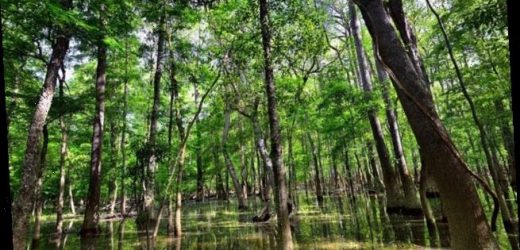Nature’s healthy soundtrack: Listening to birdsong can reduce stress while the sound of trickling water can boost positivity, study finds
- New research suggests that natural sounds positively influences human health
- Experts conducted a literature review and meta-analysis of 18 previous studies
- US national parks decrease pain, lower stress and improve mood, the team say
Natural sounds in national parks and gardens really are good for our health, a new study reveals.
North American experts investigated sound recordings from 251 sites in 66 national parks across the US as part of their study.
They found trickling water improved people’s positive emotions, while bird sounds reduced feelings of stress and annoyance.
Water was most effective at improving positive emotions, which may relate to the critical role of water for survival, the experts say, or the capacity of continuous water sounds to mask other unwanted noise.
National parks have some of the most pristine soundscapes and can bolster public health, according to the team – but they need to be protected from intrusive noise from surrounding urban areas.
Pictured, South Carolina’s Congaree National Park. New research by a team of scientists in North America shows that natural sounds are good for our health
‘Park sites near urban areas with higher levels of visitation represent important targets for soundscape conservation to bolster health for visitors,’ said Kurt Fristrup, a co-author on the study and bioacoustical scientist at the National Park Service.
‘Nature-based health interventions are increasingly common in parks and incorporating explicit consideration of the acoustic environment is an opportunity to enhance health outcomes for people.’
The sounds of nature have long generated powerful reactions in human beings – such as inspiring Beethoven’s Pastoral Symphony, the team say.
Despite their importance in human history, the growth of urbanisation has meant the presence of natural sounds without human-related noise like car horns is ‘an increasingly rare combination’.
As well as being relaxing for humans, natural soundscapes provide crucial information for wildlife, as many species rely on sound to communicate.
Two of the study authors are leaders of the Sound and Light Ecology Team at Colorado State University, which works to better understand the effects of noise and light pollution on ecological processes and organisms.
Examples of metrics of health and positive affect included improved mood and cognitive ability, and metrics of stress and annoyance included decreased pain, heart rate, and blood pressure
Most visited National Park Service sites
olden Gate National Recreation Area, 15million visitors
Blue Ridge Parkway, 14.9million
Great Smoky Mountains National Park, 12.5million
Gateway National Recreation Area, 9.4million
Lincoln Memorial, 7.8million
George Washington Memorial Parkway, 7.5million
Lake Mead National Recreation Area, 7.5million
Natchez Trace Parkway, 6.3million
Grand Canyon National Park, 5.97million
Gulf Islands National Seashore, 5.6million
Figures are for 2019 (pre-pandemic)
For their study, researchers conducted a literature review and meta-analysis of 18 publications examining the health benefits of natural sounds.
Overall, exposure to natural sounds improved mood and cognitive ability, while metrics of stress and annoyance – pain, heart rate, and blood pressure – decreased.
Compared with a mix of natural sounds, water sounds had the greatest positive outcomes on human health, whereas bird sounds had the greatest influence on relieving stress.
For the second part of their study, the team examined the distribution of natural sounds in relation to human-made sound at 221 sites across 68 US national parks.
It was hoped this part of the study would highlight how unwanted noise infiltrates national parks and gardens, compromising their serenity.
National park soundscapes with little human-made sound and abundant natural sounds occurred at only 11.3 per cent of the sites.
Among all sites, water sounds were audible 22.8 per cent of the time, and bird sounds were audible 42.1 per cent of the time.
National parks with more visitors showed similar levels of natural sounds but greater levels of human-made sounds, compared with parks with fewer annual visitors.
Most sites with low audibility of human-made sounds and high audibility of biological or geophysical sounds were far from urban areas and located in Alaska, Hawaii or the Pacific Northwest.
Visitors climb Angel’s Landing in Zion National Park. Raising awareness of natural soundscapes at national parks provides opportunities to ‘enhance visitor health outcomes’, according to the study authors
The findings suggest that preserving national parks and their natural soundscapes benefits both ecosystem conservation and public health, according to the authors.
Access to natural spaces in the last year during the current pandemic has been especially important as part of our daily exercise allowance.
‘In so many ways the Covid-19 pandemic has emphasised the importance of nature for human health,’ said study author Rachel Buxton at Carleton University, Canada.
‘As traffic has declined during quarantine, many people have connected with soundscapes in a whole new way – noticing the relaxing sounds of birds singing just outside their window.’
The study has been published today in Proceedings of the National Academy of Sciences.
HOW NOISE POLLUTION AFFECTS HEALTH
Noise can not only cause annoyance, but it can interfere with sleep, damage hearing and put people’s health at serious risk.
The World Health Organisation recommends a guideline level of 30 dB LAeq for undisturbed sleep, and a daytime level for outdoor sound levels of 50dB to prevent people from becoming ‘moderately annoyed’.
Physiological effects of exposure to noise include constriction of blood vessels, tightening of muscles, increased heart rate and blood pressure and changes in stomach and abdomen movement.
A number of reports have made direct links between transport noise and cardiac health:
- A study by Barts and the London School of Medicine in 2015, found that people surrounded by daytime traffic noise louder than 60db were 4 per cent more likely to die than those where noise levels were 55db – roughly the level of a loud conversation.
- In the first study of its kind, researchers in Denmark in 2011 found that for every ten decibels more noise, the risk of a stroke increased by 14 per cent. The risk increased by 27 per cent for those aged 65 and over.
- Research published this year that tracked thousands of people living in Amsterdam over a four year period, found that being exposed to traffic noise over 70 decibels (db) were 65% more at risk of depression.
The World Health Organisation has calculated that at least 1 million healthy life-years are lost every year in western European countries because of environmental noise.
Source: Read Full Article





